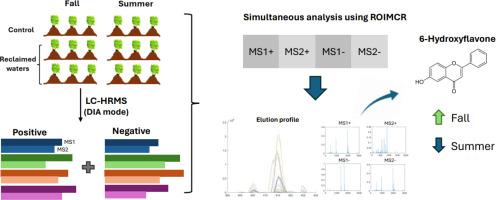Changes in the rhizosphere metabolome profile of wastewater-irrigated lettuces (Lactuca sativa L.) highlighted using non-target HRMS and ROIMCR chemometrics method
IF 6.2
引用次数: 0
Abstract
In recent decades, alternative water resources have been explored to address water scarcity; the use of reclaimed water in agricultural practices has been particularly studied. To evaluate the impact of different irrigation waters on lettuce cultures, 18 plants were grown across two seasons (fall and summer), using tap water as control, and two types of reclaimed water as substitute irrigation water sources. Samples were collected from the rhizosphere soil of the lettuces and were analyzed using Liquid Chromatography – High-Resolution Mass Spectrometry (LC-HRMS) with Data-Independent Acquisition (DIA). Non-target metabolomic profiling was performed using the Regions of Interest procedure (ROI), followed by Multivariate Curve Resolution-Alternating Least Squares (MCR-ALS) for simultaneous analysis of MS1 and MS2 signals in positive and negative ionization modes. In total, 37 chemical compounds (endogenous and exogenous) were identified belonging to different classes and origins, such as several sesquiterpene lactones or flavonoids that play a key role in the secondary metabolism of plants. Subsequent statistical and chemometric analyses highlighted that the sampling campaign season had a greater effect on the metabolomic profile than the type of water used for irrigation. Based on these findings, reclaimed waters did not exhibit sufficient influence on the rhizosphere to be discarded as a potential alternative for use in the agricultural industry.

利用非目标HRMS和ROIMCR化学计量学方法研究了污水灌溉生菜根际代谢谱的变化
近几十年来,人们一直在探索替代水资源来解决水资源短缺问题;对在农业实践中使用再生水进行了特别研究。为了评估不同灌溉用水对生菜栽培的影响,本研究采用自来水作为对照,两种再生水作为替代灌溉水源,在秋季和夏季两个季节种植18株生菜。采用数据独立采集(DIA)液相色谱-高分辨率质谱(LC-HRMS)技术对生菜根际土壤样品进行分析。非目标代谢组学分析使用感兴趣区域程序(ROI)进行,然后使用多元曲线分辨率-交替最小二乘法(MCR-ALS)同时分析正、负电离模式下的MS1和MS2信号。总共鉴定出37种不同类别和来源的化合物(内源和外源),如几种在植物次生代谢中起关键作用的倍半萜内酯或类黄酮。随后的统计和化学计量学分析强调,采样季节对代谢组学的影响比灌溉用水的类型更大。根据这些发现,再生水对根际的影响不足以将其作为一种潜在的替代方案用于农业。
本文章由计算机程序翻译,如有差异,请以英文原文为准。
求助全文
约1分钟内获得全文
求助全文

 求助内容:
求助内容: 应助结果提醒方式:
应助结果提醒方式:


